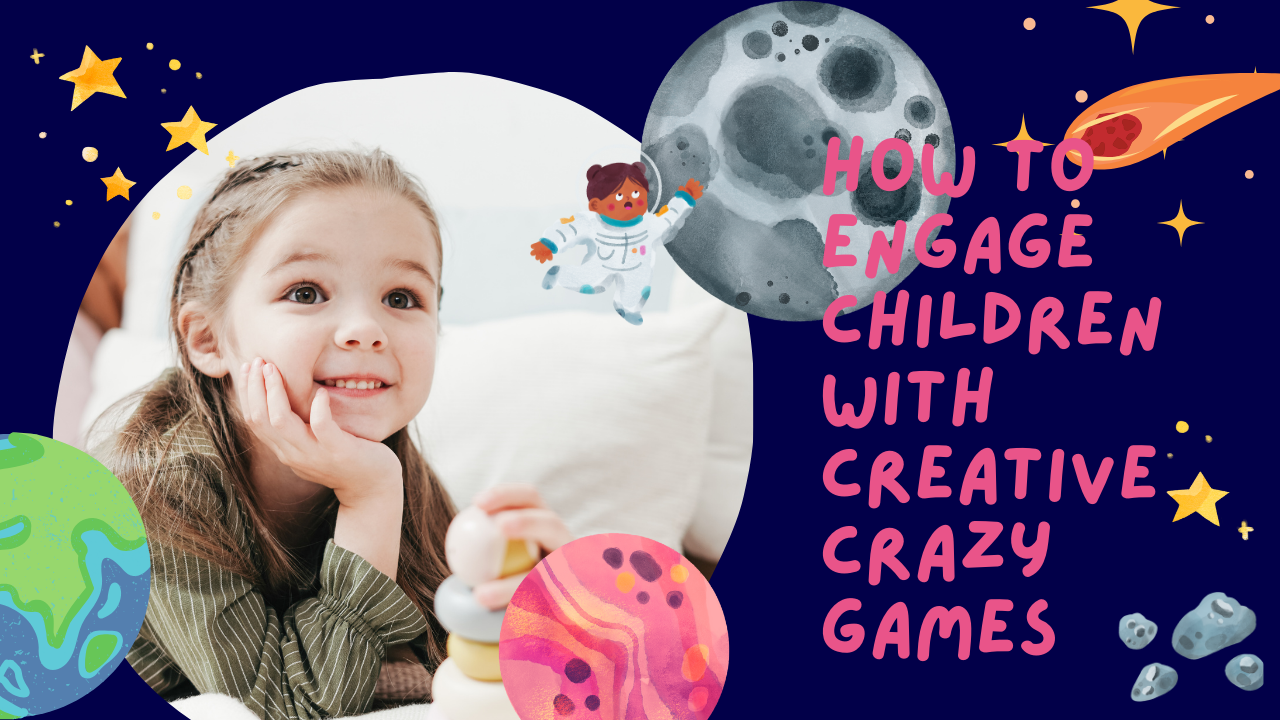Table of Contents
Introduction
Digital innovations are growing so rapidly that it’s hard to imagine a world other than the interesting and creative activities to engage kids in something aside from digital media, like the screens of a gaming, social media, or video streaming activity. It is the responsibility of a parent or educator to include activities that are entertaining yet stimulating in nature, get them active, and working towards cognitive development as well. A good example would be creative and crazy games.
These can be very fun and educative, as well. It could be an opportunity to teach new skills while having fun. In this article, we are going to discover some of the most creative and crazy game ideas that are going to keep the kids busy, happy, and growing!

1. Why Creative Games are Important for Children
Some of my favorite childhood memories are about games – whether it was an impromptu outdoor adventure or board games played around the kitchen table. It was not a way to pass time, but these games defined my creativity, social life, and the way I approach problems. To this day, I vividly remember playing with my friends, coming up with insane rules, and imagining stories for it. Values created at that very young age I never really perceived until much later were immense.
Games for children are not just play, but rather part of the development. Innovative and absurd games unleash imagination and critical thinking. They allow kids to express their feelings and attempt new ideas, as well as learn to deal with others both in cooperative and competitive situations.
Creative games that are included in a child’s daily routine make the child curious and exploratory, which develops his mental and physical abilities.
2. Benefits of Creative and Crazy Games
There are a few benefits of playing crazy and creative games with children. The most important of these are as follows:
Mental Stimulation
Creative games stimulate the brain since they make the children think out of the box. Sometimes, they need to solve a problem, strategize, or even work together as a team to win the game. Games such as treasure hunts, puzzles, or role-playing games improve cognitive skills like memory, attention, and problem-solving.
Develops Social Skills
The children play most imaginative games as groups and against themselves. In imaginary games, some skills on good communication and interpersonal skills are transferred to the kids. In an indirect way, how to take care of your disagreements is implanted. Such qualities are very nourishing as when the child steps into new scenes.
Physical Exercise
Games that require running or playing outdoors will encourage exercising the body physically. This is very important for a child’s health. Some games that involve playing tag, participating in relay races, or organizing scavenger hunts require children to move their bodies in ways that help develop coordination, strength, and motor skills.
Fosters Creativity and Imagination
Imagination is the central thing about creative games. When kids are given the freedom to make up characters, storylines, or rules, they build a creative muscle. This type of play provides a child with the ability to think creatively and not approach obstacles by a straight line.
Builds Emotional Intelligence
While playing, children learn how to deal with emotional feelings like frustration, excitement, and disappointment. Games teach the child how to handle such emotions in a healthy manner and build emotional resiliency in a child towards successes and failures.
3. Ways of making games interesting and interactive
This is my personal experience: the best games are those that have taken advantage of the interests and passions of a child. Whether it is having love for superheroes, animals, or some special movie, using any of these subjects will make the game so much more thrilling and exciting. So, here are some key tips on how to make it fun and inviting for kids:
1. Add Surprise Elements
No child will ever want to play a predictable game. An element of surprise whether it comes through sudden changes in rules or through an untold twist and surprise prize added up in the game makes them stick to their plays.
2. Suitable to be used to Boost Imagination
Children love making things up. Let them develop their rules, characters, or settings. Allow them to initiate and design components of the game. That keeps them involved in the game as if it belonged to them.
3. Simplify
While it’s fun to make a game complicated, kids typically like things easy. A straightforward game with an easy-to-follow rule is funny, if not more so, than one that is complex. Remember, it’s to keep them entertained, not to burden them.
4. Be Active
If it is outdoor or even an indoor game, then it involves body movement. These games that can make the kids run, jump, or simply move around expend energy and make kids active.

4. Great Game Ideas for Kids
Some of the following creative and crazily funny ideas will surely impress the kids and keep them engaged for hours on end:
A. Outdoor Games
1. The Great Treasure Hunt
One of the oldies but goodies is the treasure hunt. Design a treasure map or clues that lead kids around various locations. At each location, they do riddles or some kind of challenge to get the next clue. The final clue will lead them to a hidden treasure chest full of small toys or treats.
2. Human Obstacle Course
Obstacle course using household items or even outdoor equipment: The kids have to crawl under tables, jump over pillows, or balance on beams to get to the finish line. Add a competitive aspect by timing each child so that you can see who came out faster.
3. “Freeze” Game
This is such a fun game. The kids will dance or run around to the beat of the music. When the music stops, freeze in place till the music restarts. It is a very great indoor game that improves focus and concentration.
B. Indoor Games
1. DIY Bowling
Create an indoor bowling alley by using empty plastic bottles and a soft ball. The kids will try to knock down the pins one by one. To spice it up a bit, come up with varied rules, like bonus points for trick shots or using different kinds of balls.
2. Indoor Scavenger Hunt
Create a list of random items that kids have to find around the house. Catch? They only get one at a time and have to do some type of challenge before they are able to find the next, such as jumping five times.
3. Balloon Pop Relay
Every child has to sit on the balloon and burst it. Who bursts it the earliest wins the game. This can also be made into a relay race. Run them till the finishing line. There the child has to pop the balloon and then give the sign to the other child.
C. Party Games
1. Costume Charades
Charades is always a winner at parties, but with a creative twist! Kids pick out costumes and act out their charade, but they must stay in character. This encourages kids to use their imagination and have fun with different personas.
2. Crazy Hat Competition
Give the kids the newspaper, colored paper, some tape, and other things they can creatively play around with; now ask them to imagine the most ridiculous, meaningless hat they can imagine. End the activity by having fun parading your own masterpiece on the runway.
5. Teaching through Games
For sure, games do not have to be fun all the time; they can also be educational. New and imaginative games which relate to language, math, science, and history can become a great learning experience. Here is how to make your games both fun and educational:
Math Treasure Hunt: Hide the math problems in envelopes around the house or yard. Kids must solve the problem in order to get to the next clue.
Spelling Bee Relay: The race begins with a specific child spelling a word and running back to tag the next one.
Science Exploration Games: Prepare some easy science experiments that kids can conduct, for instance, how to prepare slime or make a volcano erupt. Get children to explore more about the experiment.
6. Tips for Parents and Educators
Being a parent, I have learned a few tricks to get kids excited about participating in creative games. Here are a few more tips:
Be enthusiastic: Kids feed off your energy, so be excited when suggesting new games.
Allow flexibility: Kids often have great ideas. Don’t be afraid to let them adapt and change the rules if they’re having fun.
Teamwork: Group games encourage teamwork and help children develop important social skills.
7. How to Engage the Kids
Some kids do not want to join the games. They may be shy, especially when the game requires noise-making. Here’s how you can get them to participate:
• You can begin by starting them in a small group and gradually have them enter the game.
• You can offer them incentives such as stickers or more screen time to play.
• It should be a family activity so that all members of the family can experience and learn.
8. Imaginative Games for All Ages
Games have to be suitable to the age of the children playing them. A few suggestions for games, by age are:
Age 2-4 years: Toddlers, games of “Simon Says,” building block challenges, or sensory exploration games.
Young Children (5-8): Ensure them to indulge in treasure hunts, relay race, and craft work.
Pre-teens (Age group 9-12): They excel at games that are a bit complicated, such as strategy board games or team sports trivia.

FAQ
Q1. What is the age at which children play such imaginative games?
A1: That is, at the age of two years, one can begin using creative games however most of these games are invented mainly for toddlers hence not very sophisticated. As one grows older then the complexity involved in the formulation of the game may change
Q2: How do I make sure that the games are safe to let my children play?
A2: The playground for the game is child-friendly, and the material used to play the game has no hazard in it, and watchful eyes are there that prevent accidents while outdoor games.
Q3: Creative games helpful for the cognitive development of children?
A3: Yes! It develops problem-solving, decision-making, and critical thinking skills very important for cognitive development.
Conclusion
Creative and crazy games will always make a child learn more, become more active physically, and socialize more. These can be played outside, in the house, or during parties. These can bring a lot of fun and happiness, and as much as one would expect, these can make a huge impact on how the child develops himself. So let go of your gadgets, take your kids in your arms, and get started with creative games!

